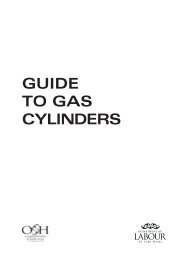Underground Petroleum Storage Tanks and Related Wastes - Code ...
Underground Petroleum Storage Tanks and Related Wastes - Code ...
Underground Petroleum Storage Tanks and Related Wastes - Code ...
Create successful ePaper yourself
Turn your PDF publications into a flip-book with our unique Google optimized e-Paper software.
not fitted with a dropper pipe unless both socket <strong>and</strong> dropper are freely vented to<br />
the upper level of the tank by means of a hole (minimum diameter 12 mm)<br />
immediately below the tank shell level.<br />
Drain or pump out any product remaining in the tank.<br />
Plug any holes, <strong>and</strong> remove the plugs from all sockets so that all pipes <strong>and</strong> entries<br />
to the top of the tank are open. Flood the tank with water from a hose that reaches<br />
to the bottom of the tank. Avoid jetting or splashing in the tank, as this could<br />
generate static electricity, causing a spark <strong>and</strong> an explosion.<br />
As water starts to flow from each nozzle or socket, close it until only the last<br />
socket at the high end of the tank is left open. Continue to run water into the tank<br />
fast enough to keep it completely full with a gentle but continuous overflow.<br />
Water must drain through a separator pit.<br />
Provided there is no product evident in or on the water that is flooding out of the<br />
tank, the tank may then be considered safe to work on as long as it is kept full of<br />
water.<br />
If, for any reason, water flooding cannot be used, a tank can also be made safe by<br />
first placing it in the same position as for water flooding outlined above, removing<br />
any product remaining in it <strong>and</strong> then dosing it with frozen carbon dioxide (obtainable<br />
from suppliers of industrial gases <strong>and</strong> commonly known as “dry ice”). The<br />
amount of dry ice needed is 2.0 kg per 1000 litres capacity (API Bulletin 16.04,<br />
1st Edition March 1981).<br />
When using dry ice, the following precautions must be taken to ensure that the<br />
tank is properly inert:<br />
• Check tank contains no product.<br />
• Open all tank top openings to allow vapour to be expelled.<br />
• Crush the dry ice.<br />
• Spread dry ice evenly over a wide area within the tank to achieve rapid<br />
evaporation.<br />
• Keep all sources of ignition away while vapour disperses.<br />
• When all dry ice has evaporated, check tank again for any residual product.<br />
If present, remove it <strong>and</strong> repeat dosage with “dry ice”.<br />
• Check via all tank openings for vapour <strong>and</strong> oxygen content using approved<br />
instruments.<br />
• Cut the tank open as soon as the tank is tested <strong>and</strong> certified gas free <strong>and</strong> the<br />
oxygen level is below 2 percent. (See section 11.11.)<br />
• Do not allow time for carbon dioxide to disperse or for the tank to “gas up”<br />
again.<br />
Alternatively, the tank can be made safe by filling with nitrogen. Liquid nitrogen<br />
should be used, <strong>and</strong> passed through an evaporator to transform it to a gas before it<br />
enters the tank. Gas must be fed into the bottom of the tank, so that air <strong>and</strong> vapour<br />
in the tank are purged out through the open nozzles, which must be at the top. The<br />
gas from the evaporator will be cold <strong>and</strong> must still be cold when it reaches the<br />
tank so that it will displace the air in the tank rather than mix with it.<br />
However, it must not be too cold. Frost will form on the evaporator <strong>and</strong> possibly<br />
on the line taking the gas to the tank. Do not allow the frosting to reach the tank.<br />
Transport <strong>and</strong> Disposal of <strong>Petroleum</strong> <strong>Storage</strong> <strong>Tanks</strong> 17





